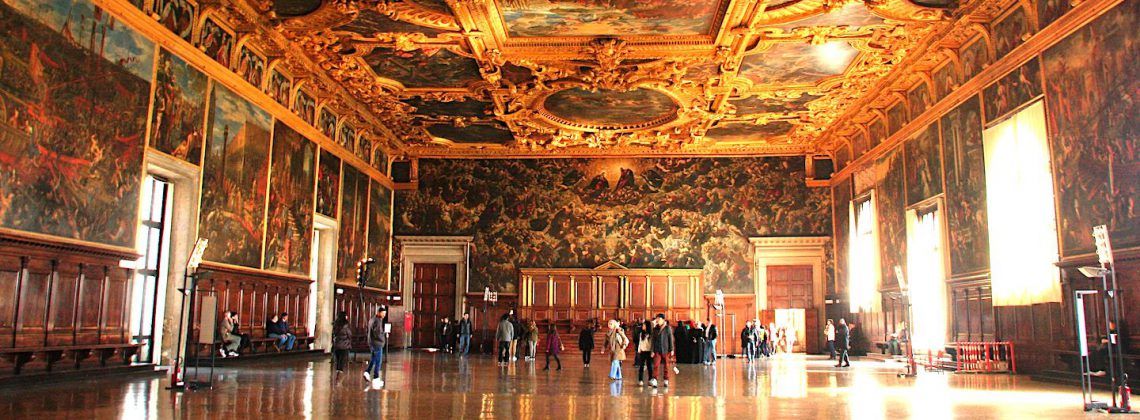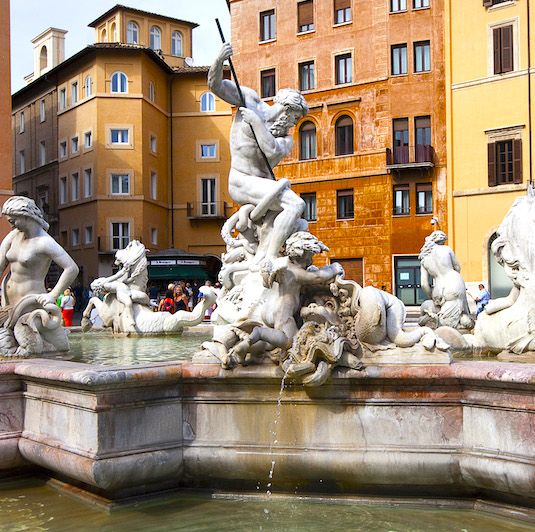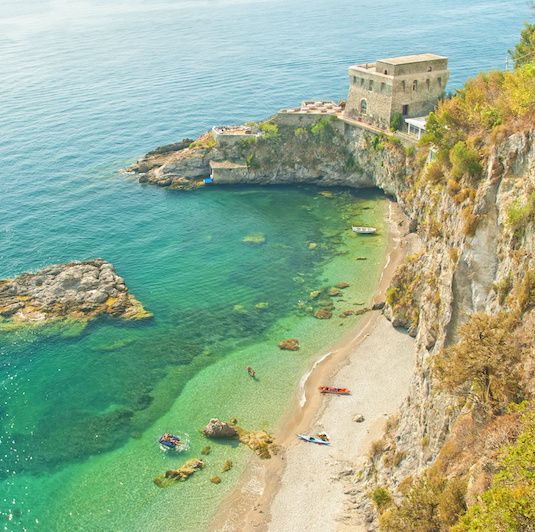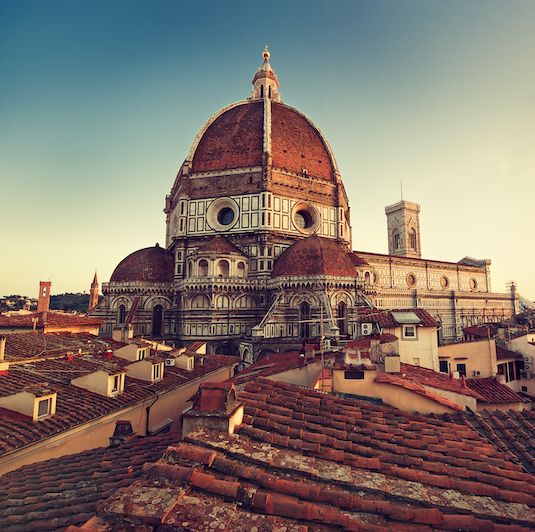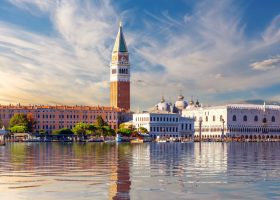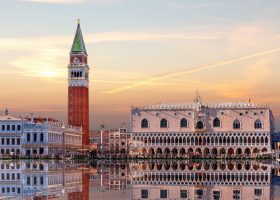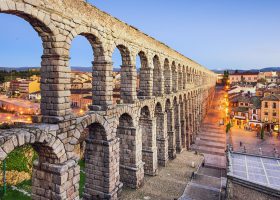The Doge’s Palace was the government center for the Venetian Republic for many centuries. As with anything that has been around for hundreds of years, there are plenty of interesting and sometimes unbelievable facts about the place. Let’s delve into them now.
12 Astounding Facts about the Doge’s Palace

Legend has it that the first settlements took place in this lagoon after the fall of the Western Roman Empire ( 476 AD). Once the Roman Empire fell, the Byzantine empire filled the vacuum in the ensuing centuries.
Since Venice is located on the Adriatic, it was much closer to the Byzantine realm of influence as opposed to Rome or other southern settlements. As a result, the architecture of the Doge’s Palace is byzantine and full of interesting stories!
12. Fires Destroyed the Palace a Few Times
A raging fire destroyed the canal side of the Palace which included the Doge’s apartments in 1483. At this time Antonio Rizzo introduced the new Renaissance style to the building. They finished the works in 1510 and replaced Rizzo with Maestro Pietro Lombardo. The new architect began the design of the facade and the Giant’s staircase in the internal courtyard.
During this period Sansovino’s created two large marble statues of Mars and Neptune at the top of the Giant’s staircase. While another fire broke out in 1574, it didn’t cause any serious damage, but mostly the wood furnishings. Hard to believe, but in 1577 another fire damaged the Sala dello Scrutinio and the Grand Council Chamber which destroyed masterpieces by Gentile da Fabriano, Pisanello, Alvise Vivarini, Carpaccio, Bellini, Pordenone, and Titian. By 1580 they had restored the area to its original appearance.
11. The Palace has a Romantic ( kind of) Bridge
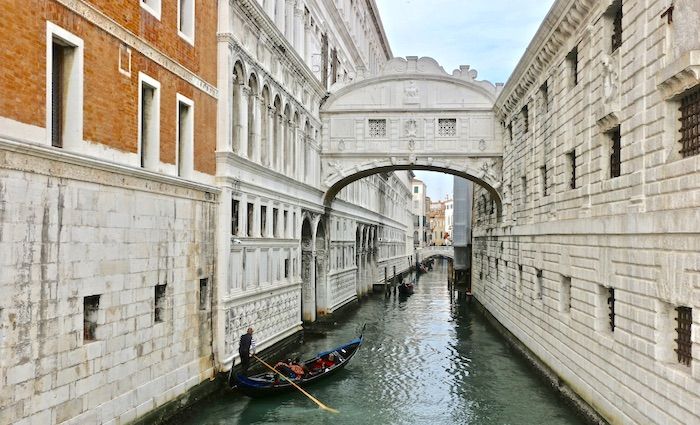
At the end of the 16th century, the Doge decided to house criminals in the next building over and not in the main building where even the Doge lived.
The name, Bridge of Sighs, comes from the Romantic Period and speaks about the sound prisoners would make after being sentenced for their crimes in the palace and taken over the bridge where they would get one last glimpse of the outside world looking at the lagoon and San Giorgio through the very small windows placed there.
While the name was popular, it was finally immortalized when the Lord Byron wrote about it in his book of 1812, ” Childe Harold’s Pilgrimage”. The famous quote is, “I stood in Venice, on the Bridge of Sighs; a palace and a prison on each hand.”
Whether the story of the sighs is true or not, it is definitely romantic. Being one of the most romantic cities in the world it is fitting as well that if you are with your loved one in a gondola under the bridge of sighs at sunset and the Bell Tower in St Marks toll, their love will last an eternity.
Popular Venice Tours
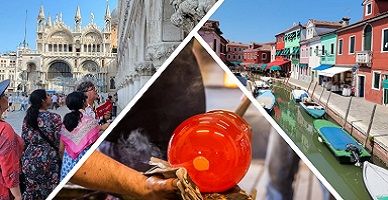
Best-Selling Tour
Ultimate Venice in a Day with Murano and Burano
The ultimate tour of Venice. You’ll get skip-the-line access to the most important buildings in Venice, plus a gondola ride, and private transportation to the islands of Murano and Burano. It’s a full day of touring that will make for the best memories in Venice ever.
See Prices
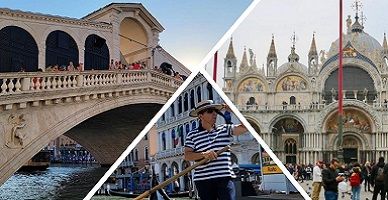
Top-Rated Tour
Venice in a Day Combo Tour with Gondola Ride
Only have a day in Venice and want to explore the best places? You’ll love this tour that includes skip-the-line access to St. Mark’s Basilica and the Doge’s Palace so you don’t waste time! Not to mention, you’ll wander through the Cannaregio district and learn about Rialto Bridge before floating through the canals on your own gondola.
See Prices
10. The Doge’s Palace’s End
The Venetian Republic fell in 1797 first to the French, then to Austria, and finally became part of a unified Italy in 1866. The Palace had been the heart of political and public administration when it had independence so it ceased to hold those functions once occupied and lost relevance.
In a state of disrepair, major renovation works began at the end of the 19th century to spruce up the Palace. Many of the original 14th-century capitals were removed to the Museo dell’ Opera for safekeeping. All the public offices were moved elsewhere except the State Office for the Protection of Historical Monuments which is still housed here. It became a museum in 1923 and in 1996 became a part of the Civic Museums of Venice network.
9. There was a Room Called Chamber of Torment
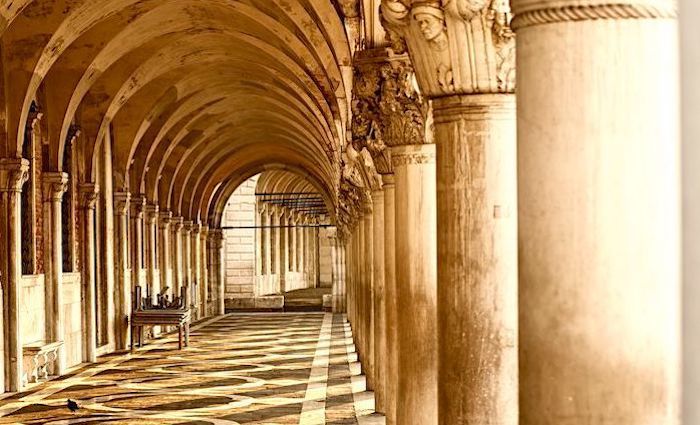
A dreaded place by the accused was the Chamber of Torment. A prisoner would be waiting in complete darkness before it was his turn to be questioned. He would hear painful screams of his fellow inmates, but these were actually fake screams by paid actors to raise the terror level more.
Here interrogations took place, where criminals were pulled by their arms with rope, while these were tied behind their back. A very painful position to be questioned in. This torture would continue until the prisoner would confess to the crime committed.
8. The Republic lasted longer than the Western Roman Empire
The council, that met in the Doge’s Palace, was made up of all the male members of patrician Venetian families over 25 years old, regardless of their individual status, merits or wealth. While not a democracy as we know it today, this system which spanned over 1,000 years created a very specific checks and balances system which didn’t allow anyone person to get too much power, including the Doge himself.
7. The Doge’s Palace had Prisons
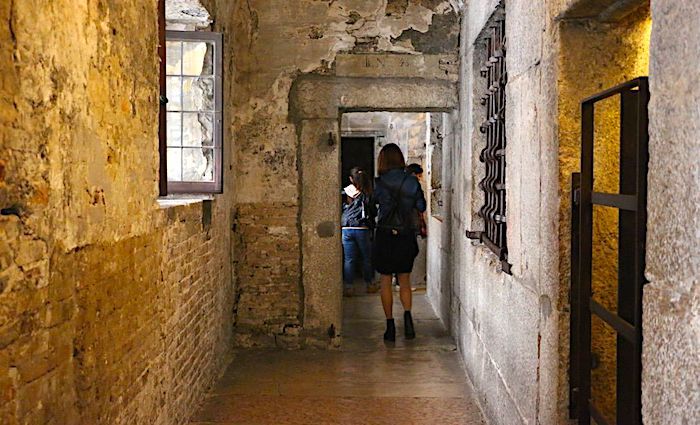
Imagine there were prisons inside the White House? Well inside the Palace where. the Doge lived, you had prisons! There were two kinds of classifications for the prisons- Pozzi and Piombi.
The Pozzi, which means “wells” in Italian, was a place of detention for prisoners, and one of the worst to be in. As you can deduce from its name, these wet little cells were hardly ventilated and reeked, making them extremely miserable cells for prisoners.
6. The Doge Lived in a Pretty Small Room
Until the 17th century, the rooms where the Doge resided were quite small and almost always less than what they had been used to in private life. This was done in a way to humble him and make him realize that his first priority was to the Republic of Venice and then about himself.
The incoming Doge would bring in his furniture and other furnishings from his private residence. Upon his death, these furnishing would be removed by his next of kin to allow the new incoming Doge to bring in his own personal belongings.
5. The Armory Contains Interesting Armor
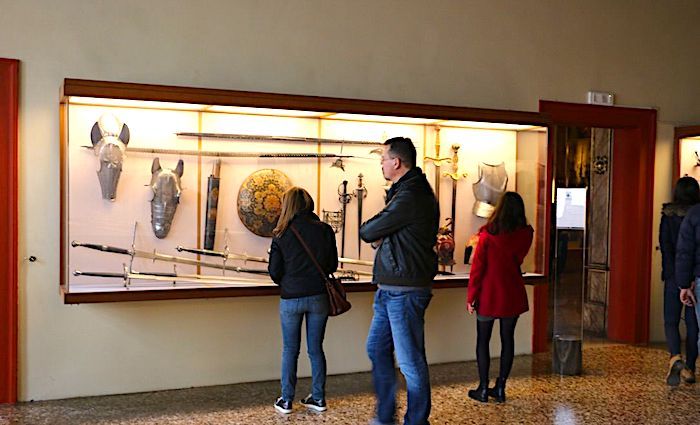
In room 1 you will find a beautiful set of armor that belonged to the famous mercenary Erasmo da Narni, whose nickname was il Gattamelata ( Honeyed Cat). He led Venice to many victories and was famous throughout Italy. Not bad for a poor farmer’s son.
While there are many suits of armor in this room, One curiosity sticks out as it is a miniature suit of armor found on the battlefield in Marignano in 1515. It would have belonged to either a child or a dwarf.
4. Capitals Telling Stories
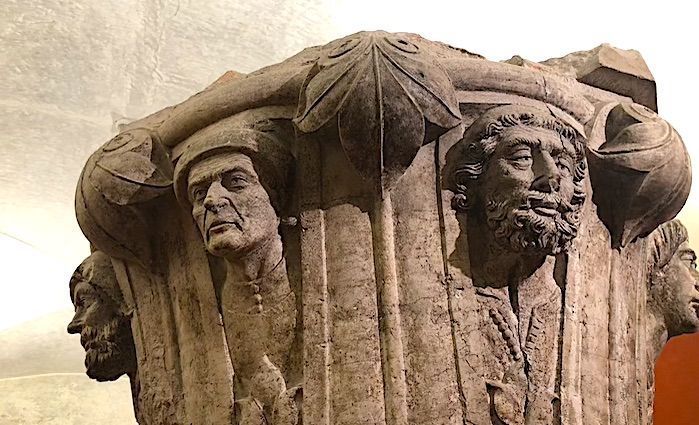
The Medieval Palace would have been richly decorated with columns and capitals that told many stories and allegories which would have been better understood by people of the time. We could say that the stories depicted were almost like an epic poem depicting men, women, animals, plants, zodiac signs, myths, symbols, vices, and virtues.
Remember that the literacy rate would have been reserved for the upper classes, so telling powerful stories through art was the best way for the general public to understand.
3. There was a Blind Doge
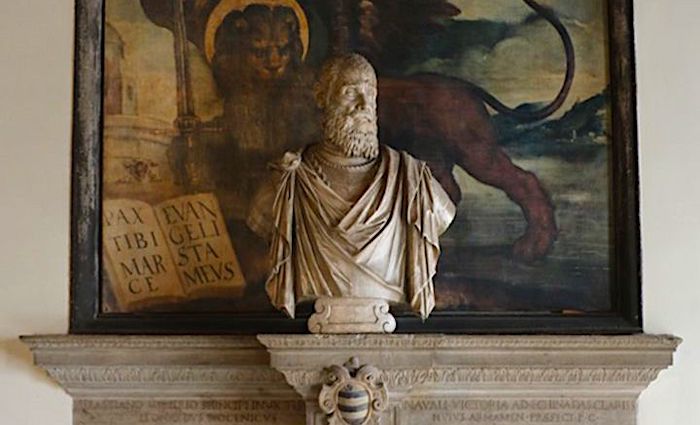
One of the Doges was blind- Enrico Dandolo. Historians disagree on the exact age, but he seemed to be in his late 70s or early 80s. One of his first decrees was to evict any foreigners who had been living in Venice for less than 2 years. Those who had been living in Venice for more than 2 years were ok for some reason oddly.
I guess you can kind of relate it to today’s Venice. The Venetian government has been trying to create rules to punish those who only come to Venice for the day ( by means of a fee to enter the city) Apparently people just coming for the day don’t spend much money. Maybe back in the day, people who were here for not long didn’t pay taxes?
2. Houses One of Biggest Rooms in Europe
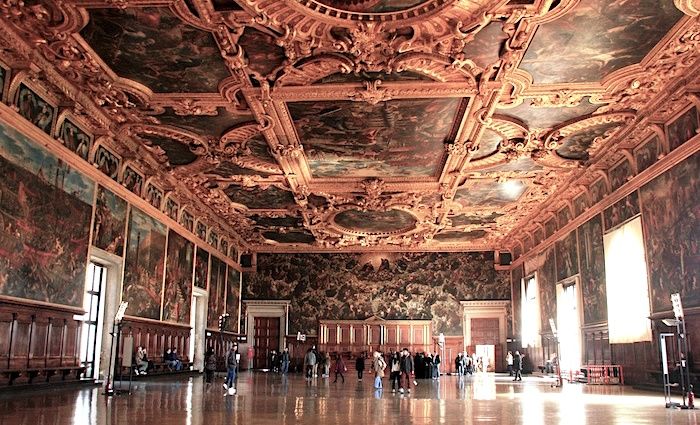
The great council chamber measures 173ft x82ft( 53m by 25m wide). Needless to say, that is huge and was even more huge back in the day. Surrounded by astonishing pieces of art, this room is where the Senate would deliberate. They would also come to agreements about financial matters and other public concerns, like the sentences for the prisoners.
One of Doge’s Palace’s artworks you’ll be able to admire in this room is Tintoretto’s Paradise. This painting is one of the largest oil paintings on canvas in history. The painting represents heaven on earth. It is said that its purpose was to look over the council in order for them to make appropriate decisions.
Unforgettable Venice Tours
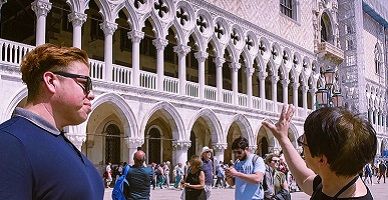
Best Selling Tour
St. Mark’s Basilica & Doge’s Palace Half-Day Tour with Gondola Ride
Get to know the best of Venice’s main attractions at St. Mark’s Square in just a few hours. You’ll have skip-the-line access at St. Mark’s Basilica. Then, head underground to the dungeons at the Doge’s Palace and cross the Bridge of Sighs.
See Prices
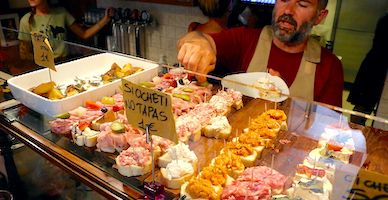
Authentic Experience
Venice Locals Evening Food Tour in Cannaregio
People who say Venice is too touristy have not done enough research. Cannaregio is an amazing break from the crowds, and our food tour is the most authentic way to experience it. Taste cicchetti and other Venetian specialties including wine. You’ll leave with a full stomach and a love for Venetian food!
See Prices
1. The 4th Crusade Was Initiated Here, But No Holy Land!
The Doge at the time was the blind Doge Enrico Dandolo ( read above). As we all know, a crusade back in the day had the purpose of taking back the Holy Land. While the original intent was to do that, let’s say they got sidetracked.
To make a long story short, they ended up conquering Constantinople which was a Christian Empire. The reason? Constantinople had showed favor to Venice’s enemies Genoa and Pisa. The blind Doge couldn’t have that and by far the easiest thing was to conquer the area. The Blind Doge actually died and was buried in Constantinople in the Hagia Sophia.
Here Is Where to Stay in the Most Popular Italian Destinations
Rome, Florence, Venice, the Amalfi Coast, and Capri
